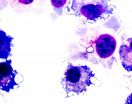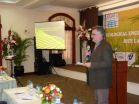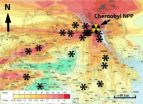(Press-News.org) Glasgow, UK: Genetic analyses of results from 1125 postmenopausal women being treated for oestrogen responsive breast cancer have shown that some of them are more likely than others to have a late recurrence of their cancer and might benefit from ten years of hormone therapy rather than five.
Prof Mitch Dowsett told the opening press conference at the European Breast Cancer Conference (EBCC-9) that his research had shown that women who had tumours that were negative for the human epidermal growth factor protein (HER2-) but which were very sensitive to the oestrogen hormone, had more than double the risk of their cancer recurring between five and ten years after surgery and five years of adjuvant hormone therapy.
"Our data suggest that these patients, who are those that appear to benefit most from the current standard five years of endocrine treatment, may also benefit from adjuvant hormone treatment that extends beyond that five years," said Prof Dowsett, who is Professor of Biochemical Endocrinology at The Institute of Cancer Research, London, UK, and Head of Biochemistry at The Royal Marsden NHS Foundation Trust, London. The work is a collaboration between his team and that of Professor Jack Cuzick at the Wolfson Institute of Preventive Medicine, Queen Mary University of London, UK.
The findings are the latest to come from the ATAC trial (Arimidex, Tamoxifen Alone or in Combination), a double-blinded phase III clinical trial that randomly assigned postmenopausal women with early, oestrogen receptor positive (ER+) breast cancer to receive the hormone therapies anastrozole or tamoxifen, or a combination of the two. [1]
Prof Dowsett and his colleagues at The Royal Marsden, The Institute of Cancer Research and Queen Mary University of London used data from the OncotypeDx® 21-gene Recurrence Score that are not usually available from this test in order to analyse the genetic make-up and to predict the likelihood of cancer recurring within ten years in these women.
"The OncotypeDx result is reported as a single score but it is made up of 16 informative genes and five control or "housekeeper" genes that we have studied in detail. Some of the 16 are considered as groups rather than individual genes, and one of these is the E-module, which consists of four genes that are related to oestrogen signalling, including the oestrogen receptor itself," he explained.
OncotypeDX has been used for over 350,000 tests and the ATAC team had previously shown that its prediction of recurrence was poorer in the second five years after a patient's diagnosis than in the first five years. The researchers wanted to find out the reason for this, and to do so they determined the relationship between the expression of the individual genes and gene modules and early (up to five years) and late (between five and ten years) recurrence rates in women with ER+ HER2- breast cancer.
They assessed the gene expression and recurrence rates in 1125 women in the ATAC trial, who had an average of ten years of follow-up. Nearly 90% of the women were HER2- and there were 215 recurrences during the ten years.
They found that recurrence rates were highest in the first five years for women with HER2+ breast cancer, compared with the subsequent five years, but for women with HER2- cancer, the recurrence rates were higher between five and ten years.
"When we looked at the women with HER2- breast cancer and defined them according to their E-module score, which indicated how sensitive to oestrogen their tumours were, we found that there was a striking difference," said Prof Dowsett. "Among women with tumours most sensitive to oestrogen, with a high E-module score, the recurrence rate more than doubled from 5.7% in the first five years to 13.6% in the subsequent five years. However, if they had a low E-module score, there was little difference in recurrence rates between the first five years and the next five years: 10.3% versus 12.3%."
The researchers say that their results show that, despite similar overall recurrence rates for patients with ER+ tumours between the first five years and the next five to ten years, there were important differences between groups of tumours with different genetic expression profiles.
"Importantly, HER2- tumours that are very sensitive to oestrogen are usually considered to be relatively low risk, yet these were the tumours that showed an increase in recurrence after five years, which coincided with the cessation of adjuvant hormonal therapy," said Prof Dowsett. "It is commonly thought that the reduction in recurrence achieved by five years of endocrine therapy 'carries-over' into the next five years. Our results suggest this effect may differ markedly between different groups of ER+ tumours. We need to do more detailed analyses on large numbers of tumours to find out if this is the case."
He said the results also suggested a way in which methods of predicting recurrence using genetic signatures may be improved. "Better predictors of recurrence than the OncotypeDX and others currently being used should be possible based on the different recurrence rates of different groups of tumours and their different sensitivity to endocrine therapy." He and his colleagues are already working to see if they achieve this.
"We are already testing over 900 tumours from the ATAC trial to see if we can identify the oestrogen-sensitive tumours better than by the genes in the Oncotype test. This will allow us to see whether, using the knowledge from this work, we can indeed create better predictors of recurrence both for the first five years and subsequent years after diagnosis," he said.
The findings could change clinical practice: women with HER2-, high oestrogen signalling breast cancer might be considered for adjuvant hormone therapy that is extended to ten years. However, the results need to be confirmed in other sets of tumours first. "This should be done by testing the tumours of patients that are participating in ongoing trials of extended versus no extended adjuvant therapy," said Prof Dowsett.
Prof Cuzick added: "It has long been known that women with ER+ cancers have a higher late recurrence rate than those with ER-negative tumours. This work makes clear that even within ER+ cancers the level of expression is important. Further work is needed to see if genetic expression profiles are better at doing this than more conventional quantitative immunohistochemistry. We are about to start a trial called IBIS-3 of extended therapy with aromatase inhibitors in long-term survivors with ER+ breast cancer with other unfavourable characteristics, and also adding new drugs used in other conditions that show promise in preventing breast cancer recurrence – a bisphosphonate (bone sparing drug) and metformin (diabetes drug). Hopefully, this biomarker work will help to pinpoint more accurately which patients need additional treatment."
Professor Giuseppe Viale, chair of EBCC-9 and Head of the Department of Pathology at the University of Milan, commented: ""Late recurrence for patients with hormone receptor-positive breast cancer after five years of endocrine treatment unfortunately is a sizeable risk, with devastating effects on the quality of life of affected patients. Clinical trials have already documented the possible benefit of extending endocrine therapy beyond five years in unselected populations of post-menopausal patients, but we do not have the means to identify the subgroup of patients actually benefitting from this extended treatment. These latest findings from the ATAC trial may pave the way for a better tailoring of hormone therapy beyond the first five years. Certainly, confirmatory studies are needed, and it remains to be assessed whether the same prognostic parameters may also hold for pre-menopausal patients."
INFORMATION:
Abstract no: O-216, "Oestrogen module of 21-gene recurrence score predict increased late recurrence for ER+HERT2- breast cancer". Thursday 20 March at 15.30-17.00 hrs. "Relapse After Systemic Treatment – Can We Predict it?" session, Clyde Auditorium.
[1] Arimidex is the trade name for anastrozole.
[2] The research was funded by AstraZeneca, Breakthrough Breast Cancer, Royal Marsden NIHR Biomedical Research Centre, Institute of Cancer Research and Cancer Research UK.
Genetic testing may help select women with ER+ breast cancer for extended hormone therapy
2014-03-19
ELSE PRESS RELEASES FROM THIS DATE:
Protein 'rescues' stuck cellular factories
2014-03-19
Using a powerful data-crunching technique, Johns Hopkins researchers have sorted out how a protein keeps defective genetic material from gumming up the cellular works. The protein, Dom34, appears to "rescue" protein-making factories called ribosomes when they get stuck obeying defective genetic instructions, the researchers report in the Feb. 27 issue of Cell.
"We already knew that binding to Dom34 makes a ribosome split and say 'I'm done,' and that without it, animals can't survive," says Rachel Green, Ph.D., a professor in the Department of Molecular Biology and Genetics ...
International team of LHC and Tevatron scientists announces first joint result
2014-03-19
Scientists working on the world's leading particle collider experiments have joined forces, combined their data and produced the first joint result from Fermilab's Tevatron and CERN's Large Hadron Collider (LHC), past and current holders of the record for most powerful particle collider on Earth.
Scientists from the four experiments involved—ATLAS, CDF, CMS and DZero—announced their joint findings on the mass of the top quark on March 19, 2014 at the Rencontres de Moriond international physics conference in Italy.
Together the four experiments pooled their data analysis ...
Social feedback loop aids language development
2014-03-19
Verbal interactions between parents and children create a social feedback loop important for language development, according to research forthcoming in Psychological Science, a journal of the Association for Psychological Science. That loop appears to be experienced less frequently and is diminished in strength in interactions with autistic children.
"This loop likely has cascading impacts over the course of a child's development," says psychological scientist and study author Anne S. Warlaumont of the University of California, Merced. "Understanding how it works and ...
Geosphere presents articles examining lithospheric evolution and geologic history
2014-03-19
Boulder, Colo., USA – Geosphere articles posted online 17 Mar. 2014 include additions to two series: "CRevolution 2: Origin and Evolution of the Colorado River System II" and "Origin and Evolution of the Sierra Nevada and Walker Lane." Other articles present new seismic data for the Slate Range of California, USA; the first detailed geologic map from the Likhu Khola region of east central Nepal; and a review of pre-21st century ideas about the origin of Grand Canyon.
Abstracts for these and other Geosphere papers are available at http://geosphere.gsapubs.org/. Representatives ...
Low doses of antianxiety drugs rebalance the autistic brain
2014-03-19
New research in mice suggests that autism is characterized by reduced activity of inhibitory neurons and increased activity of excitatory neurons in the brain, but balance can be restored with low doses of a well-known class of drugs currently used in much higher doses to treat anxiety and epileptic seizures. The findings, which are reported in the March 19th issue of the Cell Press journal Neuron, point to a new therapeutic approach to managing autism.
"These are very exciting results because they suggest that existing drugs—called benzodiazepines—might be useful in ...
Fetal Alcohol Spectrum Disorders (FASD): An under-recognized issue that may be on the rise
2014-03-19
March 19, 2014 – The open-access International Journal of Alcohol and Drug Research has released a special issue on Fetal Alcohol Spectrum Disorders (FASD), with the intention of increasing awareness of the negative effects of alcohol use in pregnancy and improving prevention, treatment and care for those living with FASD.
"In most countries, FASD is not well recognized by health professionals," says guest editor Dr. Svetlana (Lana) Popova, Senior Scientist in the Social and Epidemiological Research Department at the Centre for Addiction and Mental Health (CAMH). "If ...
Study describes first maps of neural activity in behaving zebrafish
2014-03-19
In a study published today (19/3/2014) in the scientific journal Neuron, neuroscientists at the Champalimaud Foundation, in collaboration with neuroscientists from Harvard University, describe the first activity maps at the resolution of single cells and throughout the entire brain of behaving zebrafish.
"This opens up new possibilities for studying neural circuits in the brain," says Michael Orger, principal investigator at the Champalimaud Neuroscience Programme. "In order to understand how the brain works, it is imperative that we can record the activity of the cells ...
Researchers uncover allergy-cancer connection
2014-03-19
While many are stocking up on allergy medicine in preparation for spring, a new study from researchers at Virginia Commonwealth University Massey Cancer Center has uncovered a new connection between allergy and cancer that could potentially lead to therapies involving common antihistamines.
Recently published in the Journal of Leukocyte Biology, the study was led by Daniel H. Conrad, Ph.D., member of the Cancer Cell Signaling research program at Massey and professor of microbiology and immunology at the VCU School of Medicine, with substantial contributions from Ph.D. ...
Growing rice the sustainable way: LEGATO holds its 3rd annual conference
2014-03-19
In a world facing the challenges of climate change, demographic boom and deficit in food resources, the word "sustainable" and the concept behind it become increasingly relevant. Sustainability in the way humanity uses available resources is key to a brighter and greener future.
In the context of sustainable food production, there is a clear need for crop productivity increases and diversification. Optimising rice ecosystem functions and services in Southeast Asia and their stabilisation under future land use and climate change, is the main focus of the project LEGATO ...
Radiation damage at the root of Chernobyl's ecosystems
2014-03-19
Radiological damage to microbes near the site of the Chernobyl disaster has slowed the decomposition of fallen leaves and other plant matter in the area, according to a study just published in the journal Oecologia. The resulting buildup of dry, loose detritus is a wildfire hazard that poses the threat of spreading radioactivity from the Chernobyl area.
Tim Mousseau, a professor of biology and co-director of the Chernobyl and Fukushima Research Initiatives at the University of South Carolina, has done extensive research in the contaminated area surrounding the Chernobyl ...



